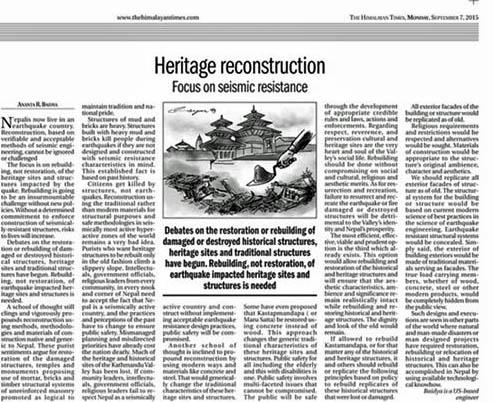
The Himalayan Times > Opinion > Heritage reconstruction: Focus on seismic resistance
Heritage reconstruction: Focus on seismic resistance
Published: September 07, 2015 2:34 am On: Opinion
Ananta R. Baidya
Debates on the restoration or rebuilding of damaged or destroyed historical structures, heritage sites and traditional structures have begun. Rebuilding, not restoration, of earthquake impacted heritage sites and structures is needed
Nepalis now live in an earthquake country. Reconstruction, based on verifiable and acceptable methods of seismic engineering, cannot be ignored or challenged The focus is on rebuilding, not restoration, of the heritage sites and structures impacted by the quake. Rebuilding is going to be an insurmountable challenge without new policies. Without a determined commitment to enforce construction of seismically-resistant structures, risks to lives will increase.
Debates on the restoration or rebuilding of damaged or destroyed historical structures, heritage sites and traditional structures have begun. Rebuilding, not restoration, of earthquake impacted heritage sites and structures is needed.
A school of thought still clings and vigorously propounds reconstruction using methods, methodologies and materials of construction native and generic to Nepal. These purist sentiments argue for restoration of the damaged structures, temples and monuments proposing use of mortar, bricks and timber structural systems of unreinforced masonry promoted as logical to maintain tradition and national pride.
Structures of mud and bricks are heavy. Structures built with heavy mud and bricks kill people during earthquakes if they are not designed and constructed with seismic resistance characteristics in mind. This established fact is based on past history.
Citizens get killed by structures, not earthquakes. Reconstruction using the traditional rather than modern materials for structural purposes and safe methodologies in seismically most active hyperactive zones of the world remains a very bad idea. Purists who want heritage structures to be rebuilt only in the old fashion climb a slippery slope.
Intellectuals, government officials, religious leaders from every community, in every nook and corner of Nepal need to accept the fact that Nepal is a seismically active country, and the practices and perceptions of the past have to change to ensure public safety. Mismanaged planning and misdirected priorities have already cost the nation dearly. Much of the heritage and historical sites of the Kathmandu Valley has been lost. If community leaders, intellectuals, government officials, religious leaders fail to respect Nepal as a seismically active country and construct without implementing acceptable earthquake resistance design practices, public safety will be compromised.
Another school of thought is inclined to propound reconstruction by using modern ways and materials like concrete and steel. That would generically change the traditional characteristics of these heritage sites and structures. Some have even proposed that Kastapmandapa ( or Maru Satta) be restored using concrete instead of wood. This approach changes the generic traditional characteristics of these heritage sites and structures. Public safety for all including the elderly and this with disabilities is one. Public safety involves multi-faceted issues that cannot be compromised. The public will be safe through the development of appropriate credible rules and laws, actions and enforcements.
Regarding respect, reverence, and preservation cultural and heritage sites are the very heart and soul of the Valley’s social life. Rebuilding should be done without compromising on social and cultural, religious and aesthetic merits. As for resurrection and recreation, failure to resurrect and recreate the earthquake or fire damaged or destroyed structures will be detrimental to the Valley’s identity and Nepal’s prosperity.
The most efficient, effective, viable and prudent option is the third which already exists. This option would allow rebuilding and restoration of the historical and heritage structures and will ensure that the aesthetic characteristics, ambience and significance remain realistically intact while rebuilding and restoring historical and heritage structures. The dignity and look of the old would remain.
If allowed to rebuild Kastamandapa, or for that matter any of the historical and heritage structures, it and others should rebuild or replicate the following principles based on policy to rebuild replicates of these historical structures that were lost or damaged.
All exterior facades of the building or structure would be replicated as of old.
Religious requirements and restrictions would be respected and alternatives would be sought. Materials of construction would be appropriate to the structure’s original ambience, character and aesthetics.
We should replicate all exterior facades of structure as of old. The structural system for the building or structure would be based on current modern science of best practices in the science of earthquake engineering. Earthquake resistant structural systems would be concealed. Simply said, the exterior of building exteriors would be made of traditional materials serving as facades. The true load carrying members, whether of wood, concrete, steel or other modern products, would be completely hidden from the public view.
Such designs and executions are seen in other parts of the world where natural and man-made disasters or man designed projects have required restoration, rebuilding or relocation of historical and heritage structures. This can also be accomplished in Nepal by using available technological knowhow.
Baidya is a US-based engineer
A version of this article appears in print on September 07, 2015 of The Himalayan Times.










Add new comment